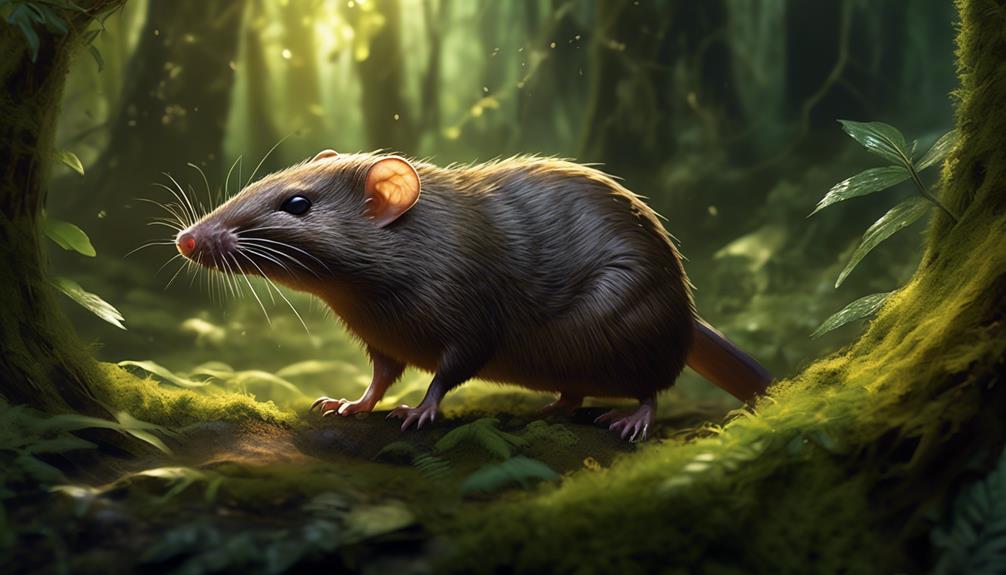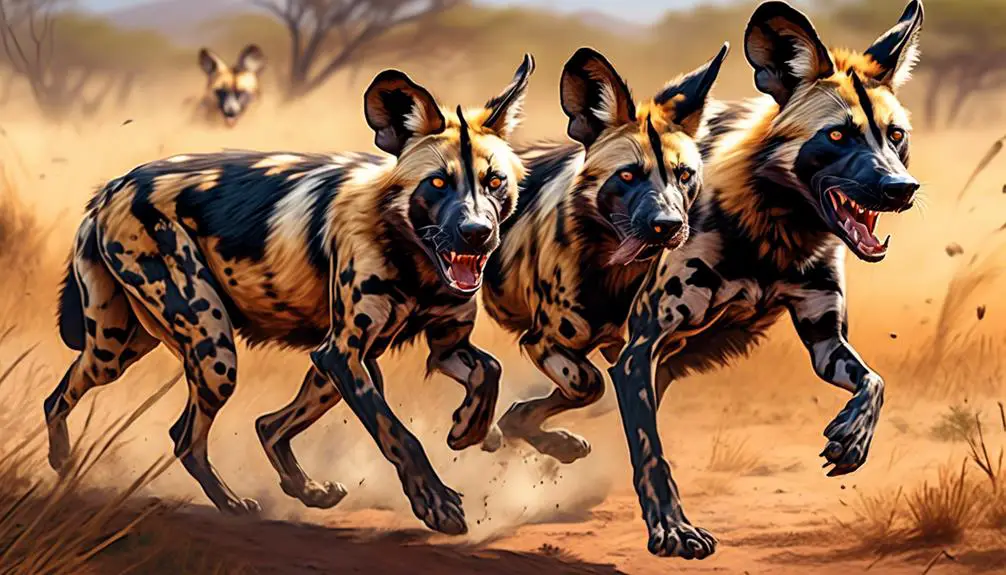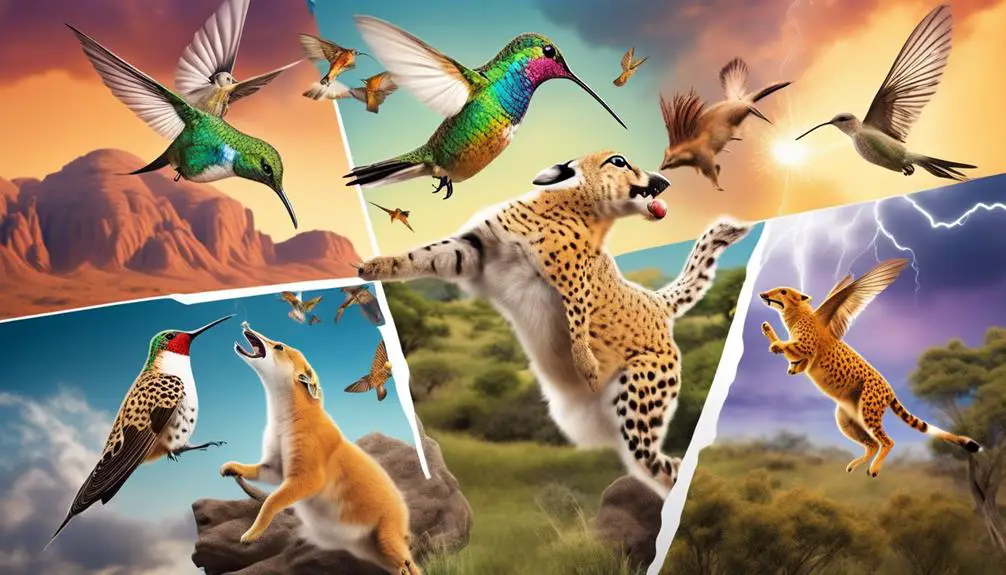Are you ready to embark on a journey through the world of the most energetic animals, like a curious explorer venturing into uncharted territory?
Brace yourself for a captivating exploration into the lives of these remarkable creatures, as we uncover their boundless energy and awe-inspiring behaviors.
From the tireless hunting skills of the African Wild Dogs to the playful antics of the Sea Otters, prepare to be amazed by the remarkable energy that fuels these extraordinary beings.
But the adventure doesn’t stop there – get ready to discover the remaining seven animals that possess an energy like no other, as we delve deeper into their fascinating lives.
Border Collies: Canine Work Ethic

Border Collies exhibit an unparalleled work ethic, making them one of the most industrious and dedicated canine breeds. Their tireless drive and commitment to completing tasks efficiently has earned them a reputation as exceptional working dogs. When given a task, Border Collies approach it with unwavering focus and determination. Their ability to concentrate for extended periods allows them to excel in various fields such as herding, agility, and obedience competitions.
One notable aspect of the Border Collie’s work ethic is their remarkable intelligence. Their cognitive abilities enable them to quickly understand and execute complex commands, making them highly efficient in their tasks. This intelligence also allows them to adapt to new challenges and problem-solve on the go, further enhancing their effectiveness.
In addition to their mental prowess, Border Collies possess incredible physical stamina. They have boundless energy and can tirelessly work for hours without showing signs of fatigue. This endurance makes them ideal for activities that require long periods of physical exertion, such as herding livestock over vast distances.
Furthermore, Border Collies exhibit a strong desire to please their handlers. They thrive on praise and are motivated by the satisfaction of a job well done. This intrinsic motivation drives them to work tirelessly and consistently deliver exceptional results.
Dolphins: Speed Swimmers and Communicators

Dolphins, highly efficient in their underwater habitat, are renowned for their exceptional speed swimming abilities and unique communication methods. They are known to be one of the fastest swimmers in the animal kingdom, reaching speeds of up to 37 miles per hour (60 kilometers per hour). Their streamlined bodies and powerful tails allow them to effortlessly glide through the water, making them incredibly agile and efficient hunters.
In addition to their impressive swimming abilities, dolphins are also known for their sophisticated communication methods. They use a combination of clicks, whistles, and body movements to convey messages to one another. These sounds travel underwater at high speeds, allowing dolphins to communicate over long distances. They have been observed using these communication methods for various purposes, such as coordinating hunting strategies, identifying individuals within their pod, and warning others of potential dangers.
To fully appreciate the speed and communication skills of dolphins, let’s take a closer look at their abilities in the following table:
| Dolphin Abilities | Speed Swimming | Communication Methods |
|---|---|---|
| Description | Dolphins are highly adept at swimming quickly, reaching speeds of up to 37 mph (60 km/h) | Dolphins use a combination of clicks, whistles, and body movements to communicate with one another |
| Importance | Speed swimming allows dolphins to quickly evade predators and efficiently catch their prey | Communication methods are crucial for coordinating hunting strategies, identifying individuals within their pod, and warning others of potential dangers |
Shrews: Energetic Hunters With High Metabolism

Shrews, small and agile mammals with a high metabolism, exhibit extraordinary energy levels as they tirelessly hunt for their prey. These tiny creatures, belonging to the Soricidae family, possess a voracious appetite that demands constant energy consumption. With their rapid metabolism, shrews require a constant intake of food to sustain their high energy levels. Their small size and quick movements allow them to navigate through dense vegetation with ease, actively searching for insects, worms, and small invertebrates to fuel their energetic foraging behavior.
Shrews showcase exceptional hunting skills, displaying remarkable agility and speed as they pursue their prey. Their active lifestyle is fueled by their high metabolic rate, which enables them to maintain a constant state of motion. Shrews are known to exhibit incredible endurance, often covering significant distances during their continuous search for food. Their relentless pursuit of prey is a testament to their unwavering energy reserves.
In addition to their hunting prowess, shrews possess a remarkable ability to adapt to various environments. These adaptable creatures can be found in a wide range of habitats including forests, grasslands, and even urban areas. Their energetic nature allows them to thrive in these diverse ecosystems, making them successful predators in their respective niches.
African Wild Dogs: Hyperactive Predators

African Wild Dogs, also known as Lycaon pictus, are hyperactive predators constantly on the move in pursuit of their prey. These remarkable animals have a unique social structure and hunting strategy that requires them to be in a state of perpetual motion. They live in packs, consisting of an alpha male and female, their offspring, and other related individuals. Within the pack, there is a clear hierarchy, with the alpha pair leading the group.
To showcase the energy and activity level of African Wild Dogs, let’s compare them to other animals known for their high energy levels:
| Animal | Energy Level |
|---|---|
| African Wild Dogs | Hyperactive Predators |
| Border Collies | Incredible Work Ethic |
| Dolphins | Speed Swimmers |
| Shrews | Energetic Hunters |
As seen in the table above, African Wild Dogs are at the top of the energy level spectrum. Their hyperactivity is critical for their survival as they rely on their exceptional stamina to chase down their prey for extended periods. They have been observed running at speeds up to 37 miles per hour, covering impressive distances in pursuit of their next meal. This constant movement requires maximum energy expenditure, making African Wild Dogs one of the most energetic animals in the world.
Sea Otters: Playful Hunters of the Sea

Sea otters, agile hunters of the sea, exhibit energetic foraging behaviors and engage in playful social interactions. With their sleek bodies and webbed feet, they skillfully navigate through the water, swiftly capturing their prey.
Their energetic foraging behaviors are evident as they spend up to 12 hours a day hunting for food, using their dexterous paws to search for shellfish and other marine delicacies.
Additionally, sea otters are known for their playful nature, engaging in social interactions such as wrestling and sliding down rocky slopes, showcasing their high energy levels and sociable behavior.
Agile Hunting Techniques
With their playful nature and remarkable agility, sea otters employ a variety of hunting techniques to secure their prey in the dynamic marine environment. These small marine mammals are known for their skillful and efficient hunting strategies.
One technique they use is called ‘tool use,’ where they use rocks or other objects to break open hard-shelled prey, such as clams and mussels.
They also display impressive diving abilities, diving up to 100 feet in search of food. Sea otters are known to be opportunistic hunters, taking advantage of any available prey, including fish, crabs, and sea urchins.
They’re also skilled at capturing fast-moving prey, using their strong forelimbs to chase and capture fish in the water.
Energetic Foraging Behaviors
The remarkable agility and playful nature of sea otters transition seamlessly into their energetic foraging behaviors, making them the epitome of playful hunters in the sea. Sea otters are carnivorous mammals that spend up to 12 hours a day hunting for food. Their foraging techniques involve a combination of diving, swimming, and searching for prey in the kelp forests they inhabit. Sea otters primarily feed on shellfish, such as clams, mussels, and sea urchins. They use their dexterous front paws to locate and capture their prey, often cracking open shells on their chest using a rock as a tool. This unique behavior showcases their intelligence and adaptability in acquiring food. Sea otters’ energetic foraging behaviors not only sustain their own survival but also play a crucial role in maintaining the balance of the marine ecosystem they inhabit.
| Foraging Behaviors | Description |
|---|---|
| Diving | Sea otters dive up to 250 feet in search of prey |
| Swimming | They use their streamlined bodies to navigate swiftly |
| Tool Usage | Sea otters use rocks to crack open shells |
Playful Social Interactions
Playful social interactions are a defining characteristic of sea otters, the energetic hunters of the sea. These captivating creatures engage in a variety of playful behaviors, often seen rolling, diving, and frolicking together in groups called rafts. Through their playful interactions, sea otters strengthen social bonds and establish hierarchies within their communities.
They engage in tactile activities, such as grooming, which not only helps maintain their fur’s insulation but also fosters social cohesion. Playful interactions also serve as a means of practicing important skills, such as hunting and defending their territories.
Sea otters exhibit remarkable coordination and agility during their play, showcasing their adaptability in the dynamic marine environment. It’s through these playful social interactions that sea otters demonstrate their exuberant energy and create a vibrant social fabric in the ocean depths.
Honeybees: Essential Pollinators and Social Organizers

Honeybees, as essential pollinators and highly organized social insects, play a crucial role in maintaining the ecological balance and biodiversity of our planet. They’re remarkable creatures that exhibit extraordinary energy and efficiency in their daily activities.
Honeybees are diligent foragers, constantly seeking nectar and pollen to sustain their hive. Each bee can visit hundreds of flowers in a single foraging trip, expending significant energy in flight. They possess specialized adaptations, such as long tongues and hairy bodies, which enable them to collect and transport pollen efficiently.
Within the hive, honeybees exhibit a remarkable social organization. Worker bees perform various tasks, from building the hive to caring for the brood and defending the colony. This division of labor ensures the smooth functioning of the hive and maximizes energy utilization. The queen bee, responsible for reproduction, can lay up to 2,000 eggs per day, further contributing to the energy dynamics of the colony.
Honeybees also play a vital role in pollination, facilitating the reproduction of flowering plants. As they visit flowers in search of nectar, they inadvertently transfer pollen from one flower to another, promoting fertilization and seed production.
Hummingbirds: Flapping Wings and Nest Builders

Hummingbirds, known for their remarkable energy, exhibit an impressive wing flapping frequency, averaging around 85 times per second. Their wings move with such speed and precision, allowing them to hover in mid-air and maneuver through intricate spaces.
In addition to their flapping prowess, hummingbirds are skilled nest builders, constructing intricate and sturdy nests using a combination of plant materials, spider silk, and their own saliva. Their non-stop construction activity showcases their tireless dedication to creating a safe and comfortable home for their offspring.
Wing Flapping Frequency
With an average wing flapping frequency of 85 times per second, hummingbirds exhibit an unparalleled level of energy expenditure as they tirelessly construct their intricate nests. This remarkable feat of aerial acrobatics requires immense strength and endurance. The rapid wing flapping creates a humming sound, hence their name. To truly appreciate the astonishing wing flapping frequency of hummingbirds, let’s compare it to other animals known for their energetic behavior:
| Animals | Wing Flapping Frequency |
|---|---|
| Hummingbirds | 85 times per second |
| Bees | 200 times per second |
| Mosquitoes | 600 times per second |
| Flies | 1,000 times per second |
As we can see, hummingbirds are exceptional in their ability to sustain such high wing flapping frequencies. This incredible energy expenditure allows them to defy gravity and build their nests with remarkable precision. It is truly a sight to behold!
Skilled Nest Builders
In the realm of skilled nest builders, one can’t overlook the awe-inspiring abilities of hummingbirds as they masterfully construct their intricate homes.
These tiny birds, belonging to the family Trochilidae, demonstrate remarkable precision and efficiency in their nest-building endeavors.
Using a combination of twigs, leaves, moss, and spider silk, hummingbirds meticulously weave together a sturdy and well-insulated structure.
The nests are often built on branches or in the forks of trees, providing a secure foundation for the delicate eggs and vulnerable hatchlings.
The attention to detail is truly remarkable, with each nest tailored to fit the specific needs of the species.
Hummingbirds’ nest-building skills are a testament to their evolutionary adaptations and resourcefulness, enabling them to create safe and comfortable homes for their offspring.
Non-stop Construction Activity
The non-stop construction activity of hummingbirds is a testament to their tireless dedication and meticulous attention to detail as they masterfully weave together twigs, leaves, moss, and spider silk to create sturdy and well-insulated nests for their offspring.
These skilled nest builders tirelessly gather materials from their surroundings, using their delicate beaks to carefully position each piece. With an average wing-flapping rate of 85 times per second, hummingbirds work swiftly and efficiently, rarely taking breaks during their construction process.
Their nests aren’t just simple structures; rather, they’re intricate and secure, designed to withstand the elements and protect their young.
The hummingbirds’ ceaseless efforts showcase their remarkable energy and commitment to providing a safe and comfortable home for their offspring.
Ants: Small but Mighty Workers

Ants, despite their small size, are incredibly industrious creatures, known for their tireless work ethic and remarkable strength. These tiny insects are capable of carrying loads that are more than fifty times their own body weight. This feat is made possible by their unique anatomy and physiology. Ants have a muscular structure that allows them to exert a tremendous amount of force, enabling them to lift and transport objects that are many times larger and heavier than themselves.
Their ceaseless digging and building activities are also remarkable. Ant colonies are intricate underground structures, consisting of chambers, tunnels, and ventilation systems. The ants work together in a coordinated manner, each individual fulfilling a specific role to ensure the success and survival of the colony. Some ants are responsible for excavating the soil, while others are tasked with gathering food, caring for the young, and defending the colony from intruders.
The efficiency and organization displayed by ants in their daily tasks is truly awe-inspiring. They communicate with each other using chemical signals, leaving pheromone trails to guide their fellow workers to food sources and other important locations. This allows them to navigate their surroundings with precision and efficiency, maximizing their energy expenditure.
Arctic Terns: Hyperactive Migrants

Arctic Terns, renowned for their hyperactive nature and impressive migrating abilities, take flight with a fervor that rivals even the most industrious ants. These birds, scientific name Sterna paradisaea, are known for their constant movement and tireless energy.
During their annual migration, they travel long distances, covering an astonishing 44,000 miles round trip. This remarkable journey takes them from the Arctic to the Antarctic and back, following a zigzag route across the globe.
Arctic Terns have adapted to their migratory lifestyle in several ways. They possess long, slender wings that allow for efficient and sustained flight, and their streamlined bodies reduce drag as they navigate through the air. Their diet consists mostly of small fish and invertebrates that they catch while in flight, ensuring a continuous supply of energy during their long journey.
These birds are highly skilled navigators, relying on a combination of celestial cues, landmarks, and magnetic fields to find their way. Their migration isn’t only driven by the search for food but also by the need to breed in the Arctic summer. This relentless pursuit of optimal breeding grounds and feeding opportunities highlights the extraordinary energy and determination of Arctic Terns.
As they soar through the skies, Arctic Terns display an unwavering commitment to their migratory journey. Their hyperactivity and constant movement are essential for their survival and successful reproduction. Witnessing their tireless flight, one can’t help but marvel at the incredible energy and endurance of these remarkable birds.
Baby Goats: Energetic Climbers and Jumpers

Baby goats, scientifically known as Capra aegagrus hircus, exhibit remarkable energy and agility as they showcase their natural abilities in climbing and jumping. These playful creatures are known for their insatiable curiosity and boundless enthusiasm, making them a joy to watch in action.
| Feature | Description |
|---|---|
| Climbing Skills | Baby goats possess an innate talent for climbing, effortlessly scaling steep slopes and rocky terrains. Their hooves, equipped with soft pads and sharp, curved claws, provide them with excellent grip and stability. |
| Jumping Ability | With their powerful hind legs, baby goats can leap to impressive heights and distances. Their muscular build and flexible joints enable them to achieve great heights while maintaining exceptional control and balance. |
| Fearlessness | Baby goats fearlessly explore their surroundings, fearlessly navigating narrow ledges and precarious surfaces. Their fearlessness, combined with their natural agility, allows them to access areas inaccessible to other animals. |
Observing baby goats in action, you can witness their relentless energy as they effortlessly climb trees, fences, and even human structures. Their nimble movements and precise footwork showcase their exceptional coordination and balance. Additionally, their fearlessness enables them to take daring leaps, jumping from elevated platforms with ease and grace.

Erzsebet Frey (Eli Frey) is an ecologist and online entrepreneur with a Master of Science in Ecology from the University of Belgrade. Originally from Serbia, she has lived in Sri Lanka since 2017. Eli has worked internationally in countries like Oman, Brazil, Germany, and Sri Lanka. In 2018, she expanded into SEO and blogging, completing courses from UC Davis and Edinburgh. Eli has founded multiple websites focused on biology, ecology, environmental science, sustainable and simple living, and outdoor activities. She enjoys creating nature and simple living videos on YouTube and participates in speleology, diving, and hiking.

